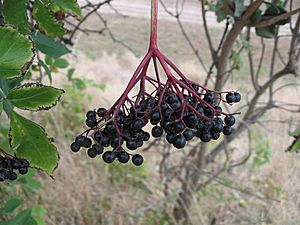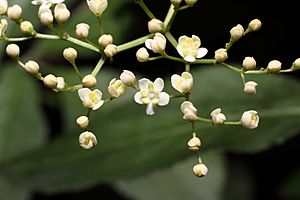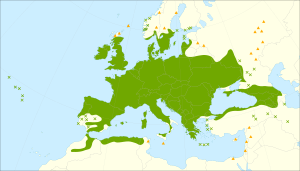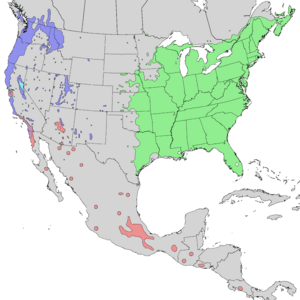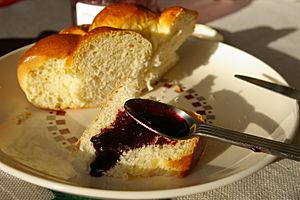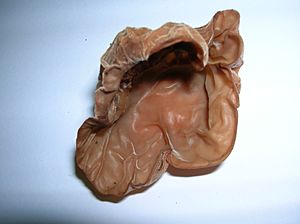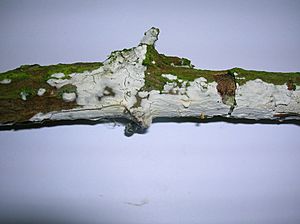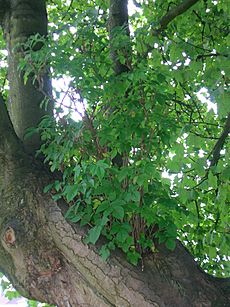Black elder facts for kids
Quick facts for kids Black elder |
|
|---|---|
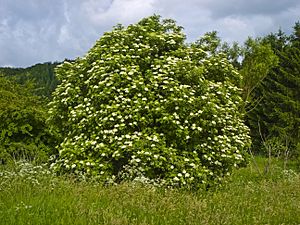 |
|
| Shrub in flower | |
| Scientific classification | |
| Genus: |
Sambucus
|
| Species: |
nigra
|
The elderberry (scientific name: Sambucus nigra) is a type of flowering plant. It belongs to the family called Adoxaceae. This plant grows naturally in most parts of Europe and North America.
People call it by many names, like elder, black elder, European elder, and European black elderberry. It can grow in many different places, from wet to dry soils, especially where it gets lots of sun. You often see elderberry plants in hedgerows and wild areas in Britain and northern Europe. People also plant it in gardens as a beautiful shrub or small tree.
Both the flowers and the berries of the elderberry plant have been used in cooking for a long time. They are often made into drinks like cordial and wine. The Latin word nigra means "black." This refers to the very dark color of the berries.
Even though elderberry is used in dietary supplements and traditional medicine, there is no scientific proof that it helps keep you healthy or treats diseases.
Contents
What Elderberry Looks Like
The elderberry is a deciduous shrub or small tree. This means it loses its leaves in the fall. It usually grows up to 6 meters (about 20 feet) tall and wide. Sometimes, it can even reach 10 meters (about 33 feet) tall.
When the bark is young, it is light grey. As the plant gets older, the bark becomes rougher and grey. It has long grooves and small spots called lenticels. These spots help the plant breathe.
The leaves grow in pairs opposite each other on the stem. They are 10–30 cm (4–12 inches) long. Each leaf has five to seven (sometimes nine) smaller leaflets. These leaflets are 5–12 cm (2–5 inches) long and 3–5 cm (1–2 inches) wide. Their edges look like tiny saws. The young stems of the plant are hollow inside.
The English name "elder" does not come from the word "old." It comes from an old Anglo-Saxon word, æld, which means "fire." This is because the hollow stems were used like bellows to blow air into a fire.
Flowers and Fruit
The elderberry flowers have both male and female parts. They have five stamens, which are the parts that make pollen. The flowers grow in large, flat clusters called corymbs. These clusters are 10–25 cm (4–10 inches) wide. They appear in late spring to mid-summer.
Each flower is small, about 5–6 mm (0.2 inches) wide, and ivory white. They have five petals. Flies help to pollinate these flowers.
The fruit is a shiny, dark purple to black berry. Each berry is 3–5 mm (0.1–0.2 inches) wide. They grow in hanging clusters in late autumn. These berries are an important food for many birds that eat fruit, especially blackcaps.
Different Types of Elderberry
There are other types of elderberry plants that are very similar. They grow in Asia and North America. Sometimes, these are considered to be different kinds of Sambucus nigra. For example, the blue or Mexican elderberry is now usually seen as a type of Sambucus nigra that grows in North America. These are called Sambucus nigra subsp. canadensis and Sambucus nigra subsp. caerulea.
Where Elderberry Lives
Elderberry plants typically grow in hedgerows, on waste-ground (areas not used for farming), along roadsides, and in woods. In Ireland, S. nigra is very common in hedges and as scrub in wooded areas.
Growing Elderberry Plants
People grow some types of elderberry plants because they look nice. These plants might have leaves with different colors or patterns. For example, Sambucus nigra f. porphyrophylla has dark maroon or black leaves and light pink flowers.
Some popular types of elderberry plants have won awards for being great garden plants. These include:
- S. nigra f. laciniata (which has cut-shaped leaves)
- S. nigra f. porphyrophylla 'Eva'
- S. nigra f. porphyrophylla 'Gerda'
Elderberry in the Kitchen
Important Safety Note: The dark blue or purple berries are a little bit poisonous if you eat them raw. Unripe berries, the seeds inside the fruit, and all green parts of the plant are poisonous. They contain natural chemicals that can make you sick.
However, the berries are safe to eat after they are cooked. People use them to make jam, jelly, chutney, and a special sauce called Pontack sauce. In some parts of Scandinavia and Germany, a soup made from elderberries (like the German Fliederbeersuppe) is a traditional meal.
People often use the elderberry flowerheads to make drinks. In Northern Europe and the Balkans, these drinks are called elderflower cordial. You can buy these drinks in stores. In Europe, the flowers are made into a syrup or cordial. You mix this with water before drinking it. This traditional drink is so popular that some companies now make elderflower-flavored soft drinks.
You can also dip the flowers into a light batter and fry them to make elderflower fritters.
The berries can also be made into elderberry wine. In Hungary, people make a strong elderberry brandy. It takes about 50 kilograms (110 pounds) of fruit to make just 1 liter (about 0.26 gallons) of this brandy. In Sweden, it is traditional to make a special drink called snaps with elderflower flavor. Elderflowers are also used in other drinks, like the liqueur St-Germain. They are also used to make a bubbly, slightly alcoholic drink called sparkling elderflower 'champagne'.
Elderberry in Traditional Medicine
Some native peoples and herbalists use this plant in traditional medicine. Extracts from the flowers and fruits are used for cold and flu symptoms. However, there is no strong scientific proof from studies that elderberry is effective for treating any disease.
Be Careful: Potential for Poisoning
Eating raw elderberries, leaves, bark, and stems can make you sick if they are not prepared correctly. This can cause nausea (feeling sick to your stomach), vomiting, and bad diarrhea. This happens because of natural toxic chemicals called cyanogenic glycosides in the plant.
Elderberry Diseases
Like other elderberry plants, Sambucus nigra can get certain fungi. These include the elder whitewash fungus and the jelly ear fungus.
Elderberry and Wildlife
Elderberry plants are a good food source for animals like mule deer, elk, sheep, and small birds. Many birds use elderberry bushes as a place to build their nests. This includes hummingbirds, warblers, and vireos.
Ripe elderberries are a favorite food for band-tailed pigeons when they migrate in northern California. These pigeons can sometimes eat all the berries from a bush very quickly. The elderberry plant is also a host for the larvae (young stage) of the spring azure butterfly. It provides good living space for both large and small mammals.
Poisonous to Mammals
Except for the flowers and ripe berries (but including the seeds inside the ripe berries), all parts of the elderberry plant are poisonous to mammals. They contain a chemical called sambunigrin. The bark also has tiny crystals called calcium oxalate.
Other Uses for Elderberry
In the past, people used the strong-smelling leaves of the elderberry plant. They would tie them to a horse's mane to help keep flies away while riding.
See also
 In Spanish: Saúco para niños
In Spanish: Saúco para niños


